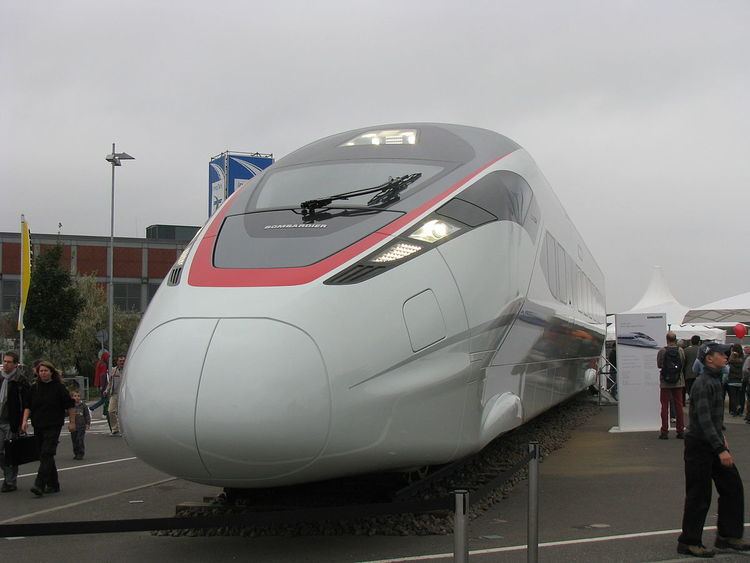Designer Bombardier | Height 3.890 m (12 ft 9.1 in) | |
 | ||
Width 2.9 or 3.4 m (9 ft 6 in or 11 ft 2 in) Wheel diameter 915 mm (36.0 in)/835 mm (32.9 in) (new/worn) Wheelbase 17.375 m (57.00 ft)
(between bogie centres) Maximum speed 250 to 380 km/h (155 to 236 mph) | ||
Bombardier Zefiro is a family of high-speed passenger trains designed by Bombardier Transportation whose variants have top operating speeds of between 250 km/h (155 mph) and 380 km/h (236 mph).
Contents
The family consists of: the Zefiro 250, which has a top operating speed of 250 km/h (155 mph) and which is for the moment wholly manufactured in China; the Zefiro 300, which has a top operating speed of 300 km/h (186 mph); and the Zefiro 380, which has a top operating speed of 380 km/h (236 mph).
Background
Bombardier transportation and its predecessor companies produced a variety of high-speed trainsets, as part collaborations with other conglomerates, such as the Intercity-Express family of locomotives (Germany), AVE Class 102, RENFE class 130 (Spain), ICN (Switzerland), the Acela express (USA), and parts of the TGV Duplex, Eurostar, Thalys, and ETR 500 trainsets (Europe various).
Additionally the company has independently produced high-speed trainsets for specific markets, such as CRH1, "Xinshisu" (China), X 2000, Regina (Sweden) and BM71 (Norway).
In November 2005 Bombardier launched its general solution, the Zefiro single-deck train for high-speed rail lines, available in 4-, 8-,12- or 16-car sets, capable of being configured for a variety of supply voltages, and produced in either standard (2.9 m or 9 ft 6 in) or a wide (3.4 m or 11 ft 2 in) widths.
Design
The Zefiro trainset is a conventional (non-inter-coach articulated) single-deck electrical-multiple-unit high-speed train. It consists of powered and unpowered cars, with motorized power cars at either end. Car bodies are constructed of aluminium, with the exception of the wide-bodied Zefiro 250 trains, the bodies of which have stainless steel bodies. They have customisable open-plan layouts.
Trains are made up of 4-car units, each of which contains a transformer and its own power supply. Typically, the end cars of each 4-car unit have powered bogies, with the two middle cars being unpowered. The pantograph is located on one of the unpowered cars.
The specifications for all current designs (2009) describe asynchronous three-phase motors, with forced air cooling. However, Bombardier also offers the option of permanent-magnet synchronous motors (which it groups in its "ECO4" energy-saving technologies), which were tested on modified Regina trains in 2008 on the "Green Train" (Swedish: Gröna Tåget).
Zefiro 250
The first variant of the Zefiro concept to be produced was a series of twenty 16-car EMU sleeper trains produced by Bombardier's joint venture Sifang Power (Qingdao) Transportation (BSP), which were delivered from 2009. These trains were the first high-speed trains license manufactured in China as well as the highest speed sleeper trains at that time.
Under China railways use they are classified class CRH1E.
Starting acceleration is greater than 0.6 m/s2 (2.0 ft/s2), with a 16-car train weight of 859 t (845 long tons; 947 short tons) and an axle load of 16.5 t (16.2 long tons; 18.2 short tons), bogie type is that found on the Regina (train) with 2.7 m (8 ft 10 in) wheelbase with 63% of axles motorized.
In July 2010 The Ministry of Railways ordered 40 more 8-car 250 km/h (155 mph) CRH1E Zefiro high-speed trains from the Sifang (Qingdao) Transportation Ltd joint venture.
In September 2012, based on a modified contract with Bombardier, The MOR ordered an additional 106 8-car trains, 60 of which are to be a new variant, designated the Zefiro 250NG. This variant is an evolution of the original, and will utilize different materials in order to provide weight savings and more efficient operation.
Zefiro 300
The Zefiro 300 is intended for European operations, with a UIC profile, and capable of being fitted for use on all four European electrification schemes (1.5 & 3 kV DC, 15 & 25 kV AC). Bogies are FLEXX type with a 2.85 m (9 ft 4 in) wheelbase, 50% of which are motorized. Starting acceleration is greater than 0.60 m/s2 (2.0 ft/s2). It has an axle load of approximately 17 t (16.7 long tons; 18.7 short tons). Two 8-car sets can be joined together to form one longer train.
A variant of the Zefiro 300 was offered by Bombardier in association with AnsaldoBreda to Trenitalia, the Italian national railway service, as part of a bid for 50 new high-speed trainsets in 2010. Trenitalia selected this bid as the winner on 5 August 2010. These entered service in 2015 and are designated ETR 1000.
Zefiro 380
In September 2009, Bombardier announced an order for eighty Zefiro 380 high-speed trains by the Chinese Ministry of Railways (MOR) to be produced at Bombardier's joint venture Sifang (Qingdao) Transportation Ltd. The order of twenty 8-car sets and sixty 16-car sets was estimated to be worth 27.4 billion RMB (approx €2.7 billion or $4 billion). The value of Bombardier's share is estimated at €1.3 billion.
Under China railways use these trains have been designated CRH1C (8-car set) and CRH1D (16-car set). which was in December 2010 revised to CRH380C and CRH380CL and once again to CRH380D (8-car set) & CRH380DL (16-car set) according to the new numbering system.
As of the most recent news, the order has been amended to include only seventy 8-car sets, designated as the CRH380D. Orders for the 16-car DL sets were converted to D sets in late 2011.
The first three sets have been delivered, with the first undergoing testing.
